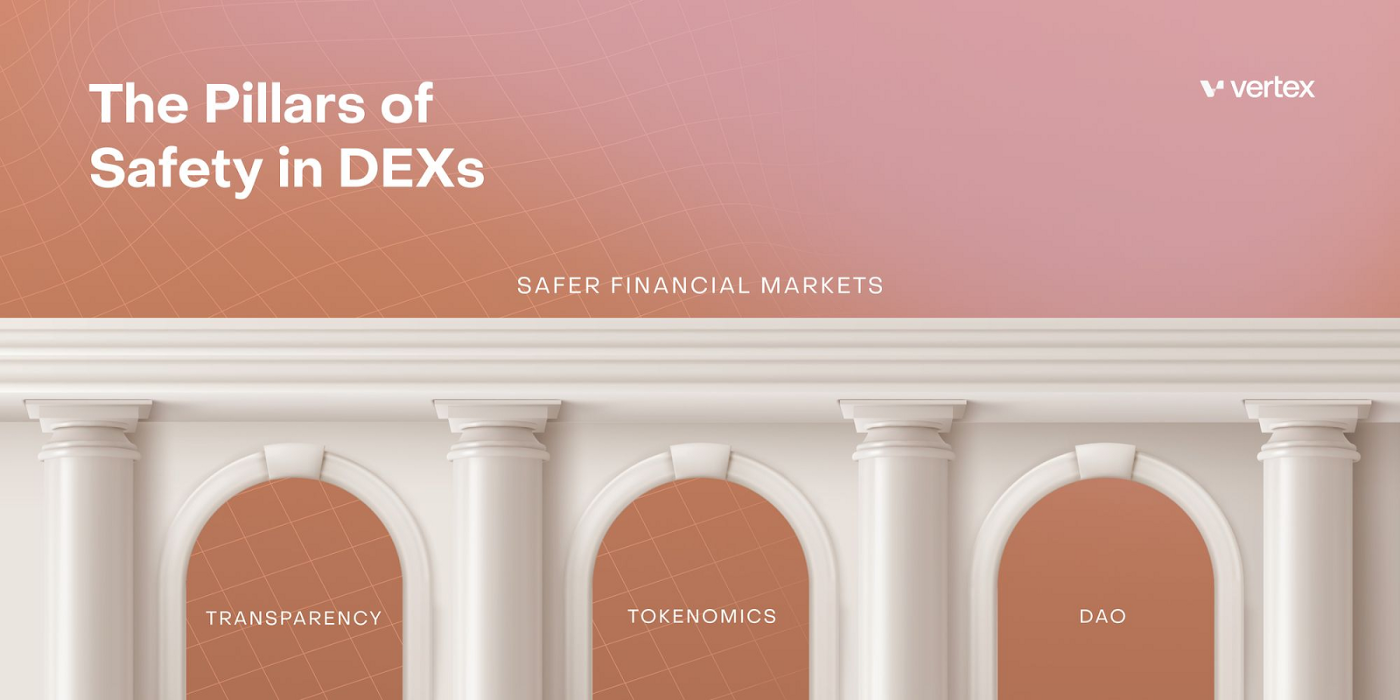Part 4: The Benefits of Decentralization & Market Safety

TLDR: Transparency, tokenomics, and DAO governance allow decentralized exchanges to reduce risk in financial markets.
This series has introduced the concept that exchanges are public goods. We argue that for various reasons, we ought to prefer DEXs over CEXs. Much of what we covered has dealt with user experience on an individual basis. Decentralizing exchanges, however, has macro-level impacts on the market as well. Below we discuss how decentralization facilitates market safety.
Financial markets have always exhibited numerous risks. Until recently, trading high-volume assets on centralized venues was characterized by a lack of transparency and fairness between market participants. Market players with abundant capital have exclusive access to specific “trades” (e.g., structured, OTC products) and can obscure their positions from the public.
They maintain unique relationships with brokerages which provides them preferential treatment.
Decentralizing exchanges solves this problem with a few unique qualities:
- Transparency — Trades and positions are displayed on-chain. It’s difficult to hide if you’re a big player since DeFi users are constantly monitoring what the “whales” do on-chain.
- Tokenomics — Utility tokens can distribute support for an exchange’s risk-management infrastructure. Users can participate and profit from their service while stabilizing market architecture.
- Decentralized governance — DAOs may harness community input and experience to construct suitable safeguards that mitigate risks.
Transparency
Systemic risks typically arise from perverse incentive structures or subsidies that skew healthy and rational behavior.
In crypto, this generally results in one-sided directional bets across the ecosystem, with many traders using excessive leverage. Margin calls due to volatility trigger cascading liquidations which rapidly drain liquidity and crash prices.
DeFi’s transparency is an excellent remedy to the prevailing issues plaguing CEXs. Untenable behaviors and misaligned incentives are unlikely when visible to all market participants on-chain. Smart and active traders can spot irrational risk earlier, allowing them to hedge exposure and alleviate systemic risk — lowering it to acceptable levels within the broader ecosystem.
Centralization creates opacity, which obscures many instances of unsafe risk-taking. Brokerages experience pressure to give preferential treatment (i.e., allow greater risk-taking than expected) to keep large players’ business. The resulting opacity allows one-sided risk to accumulate, converting poor risk-taking from an individual issue into a systemic one.
DeFi mitigates the opacity of CEXs.
Undercollateralized positions are subjected to a market of specialized arbitrageurs searching for liquidation opportunities. Unlocking liquidations for dedicated liquidators adept in searching for underwater positions (earning arbitrage profits or liquidation fees) produces significantly better transparency for an exchange’s user base.
Prices more accurately reflect reality, including the one-sided leverage and other risks. There is no preferential treatment and no partial relationships. DeFi is transparent, and its fairness engenders greater market security by eliminating hazardous risk-taking before it becomes a systemic issue.
Tokenomics
DEXs may also use tokenomics to distribute risk to willing volunteers with a stake in an ecosystem. One example is staking tokens as a backstop to the insurance fund.
If capital deployed from the insurance fund covers a trader’s position in default, the staked tokens can be used as payment to cover the owed difference. Yield-bearing insurance fund staking further incentivizes participation in the DEX by offering a reward for supporting the system.
Compared to socialized losses, insurance fund staking allows people to step up as willing profit-seekers and risk-taking volunteers rather than unwilling victims of a risk-management failure.
Governance
No system can be pre-programmed for every potential circumstance. DAOs create market security by leveraging the collective wisdom of engaged and educated users to build a better exchange — improving insight into unforeseen external circumstances.
Over time, DAOs can materialize an exchange that deals with new financial risks or develop financial safeguards that propel future growth. Only decentralized systems offer the mechanisms and ethos to support community-led development of this kind.
—
Proper exchange design mitigates unnecessary financial market risks. Vertex will focus on the three pillars of Transparency, Tokenomics, and Governance to build a robust and secure exchange for all participants.
Why Vertex Benefits You — The User
Over the course of this series, we’ve discussed the rationale behind decentralizing exchanges.
Topics included the Ideal Exchange’s rich features set, and how decentralized governance allows exchanges to serve their communities better — realizing these ideals can only happen when market safety is paramount.
Healthy decentralization facilitates a public good safe for public use.
Today, we can leverage blockchain technology to de-monopolize the public good which is so crucial to economies and as a hub of activity within DeFi. We can craft tokenomics and governance procedures to best incentivize long-term community participation, stability, and growth. Decentralization offers users self-custody, and provides the market with greater security and transparency. Users can opt into this system at will, shaping the qualities of a DEX via governance without sacrificing the convenience of incumbent CEXs.
Vertex imbues these insights into a vertically-integrated product suite to create a brighter future for finance. The design and engineering structure embedded into Vertex reflect the ultimate exchange — suitable for the needs of all users.
This is why Vertex Protocol stands superior. With a matching engine containing just a 90 millisecond delay from order confirmed to order filled — Vertex rivals the speed of CEXs. It’s time for DEXs to evolve, offering users the feature-rich benefits of CEXs with the power of decentralized applications.
As more assets become tokenized, they will find a place on Vertex. As more people discover the wonders of DeFi, they will find a place on Vertex.